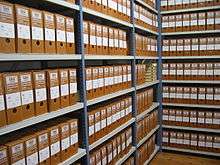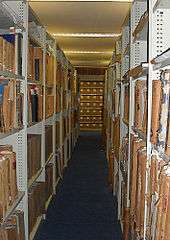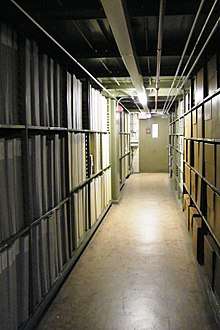Archive
An archive is an accumulation of historical records – in any media – or the physical facility in which they are located.[1] Archives contain primary source documents that have accumulated over the course of an individual or organization's lifetime, and are kept to show the function of that person or organization. Professional archivists and historians generally understand archives to be records that have been naturally and necessarily generated as a product of regular legal, commercial, administrative, or social activities. They have been metaphorically defined as "the secretions of an organism",[2] and are distinguished from documents that have been consciously written or created to communicate a particular message to posterity.

In general, archives consist of records that have been selected for permanent or long-term preservation on grounds of their enduring cultural, historical, or evidentiary value. Archival records are normally unpublished and almost always unique, unlike books or magazines of which many identical copies may exist. This means that archives are quite distinct from libraries with regard to their functions and organization, although archival collections can often be found within library buildings.[3]
A person who works in archives is called an archivist. The study and practice of organizing, preserving, and providing access to information and materials in archives is called archival science. The physical place of storage can be referred to as an archive (more usual in the United Kingdom), an archives (more usual in the United States), or a repository.[4][5]
The computing use of the term "archive" should not be confused with the record-keeping meaning of the term.
Etymology
The English word archive /ˈɑːrkaɪv/ is derived from the French archives (plural), and in turn from Latin archīum or archīvum,[6] the romanized form of the Greek ἀρχεῖον (arkheion). The Greek term originally referred to the home or dwelling of the Archon, a ruler or chief magistrate, in which important official state documents were filed and interpreted; from there its meaning broadened to encompass such concepts as "town hall" and "public records".[7] The root of the Greek word is ἀρχή (arkhē), meaning among other things "magistracy, office, government",[8] and derived from the verb ἄρχω (arkhō), meaning "to begin, rule, govern" (also the root of English words such as "anarchy" and "monarchy").[9]
The word archive is first attested in English in the early 17th century, and the word archivist in the mid 18th century, although in these periods both terms are usually found used only in reference to foreign institutions and personnel. Not until the late 19th century did they begin to be used at all widely in domestic contexts.[5][10]
The adjective formed from archive is archival.
History
The practice of keeping official documents is very old. Archaeologists have discovered archives of hundreds (and sometime thousands) of clay tablets going back to the third and second millennia BC in sites like Ebla, Mari, Amarna, Hattusas, Ugarit, and Pylos. These discoveries have been fundamental to know ancient alphabets, languages, literature, and politics.
Archives were well developed by the ancient Chinese, the ancient Greeks, and ancient Romans (who called them Tabularia). However, they have been lost, since documents written on materials like papyrus and paper deteriorated at a faster pace, unlike their stone tablet counterparts. Archives of churches, kingdoms, and cities from the Middle Ages survive and have often kept their official status uninterruptedly until now. They are the basic tool for historical research on these ages.[11]
England after 1066 developed archives and archival research methods.[12] The Swiss developed archival systems after 1450.[13]
Modern archival thinking has many roots from the French Revolution. The French National Archives, who possess perhaps the largest archival collection in the world, with records going as far back as 625 A.D., were created in 1790 during the Revolution from various government, religious, and private archives seized by the revolutionaries.[14]
Users and institutions

Historians, genealogists, lawyers, demographers, filmmakers, and others conduct research at archives.[15] The research process at each archive is unique, and depends upon the institution that houses the archive. While there are many kinds of archives, the most recent census of archivists in the United States identifies five major types: academic, business (for profit), government, non-profit, and other.[16] There are also four main areas of inquiry involved with archives: material technologies, organizing principles, geographic locations, and tangled embodiments of humans and non-humans. These areas help to further categorize what kind of archive is being created.
Academic

Archives in colleges, universities, and other educational facilities are typically housed within a library, and duties may be carried out by an archivist.[17] Academic archives exist to preserve institutional history and serve the academic community.[18] An academic archive may contain materials such as the institution's administrative records, personal and professional papers of former professors and presidents, memorabilia related to school organizations and activities, and items the academic library wishes to remain in a closed-stack setting, such as rare books or thesis copies. Access to the collections in these archives is usually by prior appointment only; some have posted hours for making inquiries. Users of academic archives can be undergraduates, graduate students, faculty and staff, scholarly researchers, and the general public. Many academic archives work closely with alumni relations departments or other campus institutions to help raise funds for their library or school.[19] Qualifications for employment may vary. Entry-level positions usually require an undergraduate diploma, but typically archivists hold graduate degrees in history or library science (preferably certified by a body such as the American Library Association).[20] Subject-area specialization becomes more common in higher ranking positions.[21]
Business (for profit)
Archives located in for-profit institutions are usually those owned by a private business. Examples of prominent business archives in the United States include Coca-Cola (which also owns the separate museum World of Coca-Cola), Procter and Gamble, Motorola Heritage Services and Archives, and Levi Strauss & Co. These corporate archives maintain historic documents and items related to the history and administration of their companies.[22] Business archives serve the purpose of helping their corporations maintain control over their brand by retaining memories of the company's past. Especially in business archives, records management is separate from the historic aspect of archives. Workers in these types of archives may have any combination of training and degrees, from either a history or library background. These archives are typically not open to the public and only used by workers of the owner company, though some allow approved visitors by appointment.[23] Business archives are concerned with maintaining the integrity of their company, and are therefore selective of how their materials may be used.[24]
Government

Government archives include those maintained by local and state government as well as those maintained by the national (or federal) government. Anyone may use a government archive, and frequent users include reporters, genealogists, writers, historians, students, and people seeking information on the history of their home or region. Many government archives are open to the public and no appointment is required to visit.[25]
In the United States, National Archives and Records Administration (NARA) maintains central archival facilities in the District of Columbia and College Park, Maryland, with regional facilities distributed throughout the United States. Some city or local governments may have repositories, but their organization and accessibility varies widely.[26] Similar to the library profession, certification requirements and education also varies widely, from state to state.[27] Professional associations themselves encourage the need to professionalize.[28] NARA offers the Certificate of Federal Records Management Training Program for professional development.[29] The majority of state and local archives staff hold a bachelor's degree[30]—increasingly repositories list advanced degrees (e.g. MA, MLS/MLIS, PhD) and certifications as a position requirement or preference.[20]
In the UK, the National Archives (formerly known as the Public Record Office) is the government archive for England and Wales. The English Heritage Archive is the public archive of English Heritage. The National Archives of Scotland, located in Edinburgh, serve that country while the Public Record Office of Northern Ireland in Belfast is the government archive for Northern Ireland.
A network of county record offices and other local authority-run archives exists throughout England, Wales, and Scotland and holds many important collections, including local government, landed estates, church, and business records. Many archives have contributed catalogues to the national "Access to Archives" programme and online searching across collections is possible.
In France, the French Archives Administration (Service interministériel des Archives de France) in the Ministry of Culture manages the National Archives (Archives nationales), which possess 406 km. (252 miles) of archives as of 2010 (the total length of occupied shelves put next to each other), with original records going as far back as A.D. 625, as well as the departmental archives (archives départementales), located in the préfectures of each of the 100 départements of France, which possess 2,297 km. (1,427 miles) of archives (as of 2010), and also the local city archives, about 600 in total, which possess 456 km. (283,4 miles) of archives (as of 2010).[31] Put together, the total volume of archives under the supervision of the French Archives Administration is the largest in the world.
In India, the National Archives (NAI) are located in New Delhi.
In Taiwan, the National Archives Administration are located in Taipei.[32]
Most intergovernmental organisations keep their own historical archives. However, a number of European organisations, including the European Commission, choose to deposit their archives with the European University Institute in Florence.[33]
Church
A prominent Church Archives is the Vatican Secret Archive.[34] Archdioceses, dioceses, and parishes also have archives in the Roman Catholic and Anglican Churches. Very important are monastery archives, because of their antiquity, like the ones of Monte Cassino, Saint Gall, and Fulda. The records in these archives include manuscripts, papal records, local Church records, photographs, oral histories, audiovisual materials, and architectural drawings.
Most Protestant denominations have archives as well, including the Presbyterian U.S.A Historical Society,[35] The Moravian Church Archives,[36] The Southern Baptist Historical Library and Archives,[37] the United Methodist Archives and History Center of the United Methodist Church,[38] and the Christian Church (Disciples of Christ).[39]
Films
Non-profit
Non-profit archives include those in historical societies, not-for-profit businesses such as hospitals, and the repositories within foundations. Non-profit archives are typically set up with private funds from donors to preserve the papers and history of specific persons or places. Often these institutions rely on grant funding from the government as well as the private funds.[40] Depending on the funds available, non-profit archives may be as small as the historical society in a rural town to as big as a state historical society that rivals a government archives. Users of this type of archive may vary as much as the institutions that hold them. Employees of non-profit archives may be professional archivists, para-professionals, or volunteers, as the education required for a position at a non-profit archive varies with the demands of the collection's user base.[41]
Web archiving
Web archiving is the process of collecting portions of the World Wide Web and ensuring the collection is preserved in an archive, such as an archive site, for future researchers, historians, and the public. Due to the massive size of the Web, web archivists typically employ web crawlers for automated collection.
Similarly, software code and documentation can be archived on the web, as with the example of CPAN.
Other
Some archives defy categorization. There are tribal archives within the Native American nations in North America, and there are archives that exist within the papers of private individuals. Many museums keep archives in order to prove the provenance of their pieces. Any institution or persons wishing to keep their significant papers in an organized fashion that employs the most basic principles of archival science may have an archive. In the 2004 census of archivists taken in the United States, 2.7% of archivists were employed in institutions that defied categorization. This was a separate figure from the 1.3% that identified themselves as self-employed.[42]
Another type of archive is the Public Secrets project.[43] This is an interactive testimonial, in which women incarcerated in the California State Prison System describe what happened to them. The archive's mission is to gather stories from women who want to express themselves, and want their stories heard. This collection includes transcripts and an audio recording of the women telling their stories.
The archives of an individual may include letters, papers, photographs, computer files, scrapbooks, financial records, or diaries created or collected by the individual – regardless of media or format. The archives of an organization (such as a corporation or government) tend to contain other types of records, such as administrative files, business records, memos, official correspondence, and meeting minutes.
Standardization
The International Council on Archives (ICA) has developed a number of standards on archival description including the General International Standard Archival Description ISAD(G).[44] ISAD(G) is meant to be used in conjunction with national standards or as a basis for nations to build their own standards.[45] In the United States, ISAD(G) is implemented through Describing Archives: A Content Standard, popularly known as "DACS".[46] In Canada, ISAD(G) is implemented through the Council of Archives[47] as the Rules for Archival Description, also known as "RAD".[48]
Protection
The cultural property stored in archives is threatened by natural disasters, wars or other emergencies in many countries. International partners for archives are UNESCO and Blue Shield International in accordance with the Hague Convention for the Protection of Cultural Property from 1954 and its 2nd Protocol from 1999. From a national and international perspective, there are many collaborations between archives and local Blue Shield organizations to ensure the sustainable existence of cultural property storage facilities. In addition to working with the United Nations peacekeeping in the event of war, the protection of the archives requires the creation of "no strike lists", the linking of civil and military structures and the training of local personnel.[51][52][53][54]
See also
References
- "Glossary of Library and Internet Terms". University of South Dakota Library. Archived from the original on 10 March 2009. Retrieved 30 April 2007.
- Galbraith, V. H. (1948). Studies in the Public Records. London. p. 3.
- "A Glossary of Archival and Records Terminology". Society of American Archivists. Archived from the original on 15 June 2013. Retrieved 7 December 2012.
- "Glossary of Archival and Records Terminology". Society of American Archivists. Archived from the original on 22 October 2013. Retrieved 21 October 2013.
- "archive, n.". Oxford English Dictionary (3rd ed.). Oxford University Press. September 2005. (Subscription or UK public library membership required.)
- archīum Archived 24 September 2015 at the Wayback Machine, Charlton T. Lewis, Charles Short, A Latin Dictionary, on Perseus
- ἀρχεῖον Archived 9 October 2012 at the Wayback Machine, Henry George Liddell, Robert Scott, A Greek-English Lexicon, on Perseus
- ἀρχή Archived 6 June 2011 at the Wayback Machine, Henry George Liddell, Robert Scott, A Greek-English Lexicon, on Perseus
- ἄρχω Archived 18 June 2013 at the Wayback Machine, Henry George Liddell, Robert Scott, A Greek-English Lexicon, on Perseus
- Procter, Margaret (2010). "What's an 'archivist'? Some nineteenth-century perspectives". Journal of the Society of Archivists. 31 (1): 15–27.
- Murray, Stuart (2009). The Library: An Illustrated History. New York: Skyhorse Publishing. p. 7. ISBN 978-1-61608-453-0.
- Michael T. Clanchy, From Memory to Written Record: England 1066–1307 (Blackwell, 1979).
- Randolph Head, "Knowing Like a State: The Transformation of Political Knowledge in Swiss Archives, 1450–1770", Journal of Modern History, 75 (2003), pp. 745-82. online
- "archive: Definition, Synonyms from". Answers.com. Archived from the original on 23 May 2010. Retrieved 1 June 2010.
- "What Are Archives?". National Museum of American History. Archived from the original on 5 September 2014. Retrieved 2 September 2014.
- Walch, Victoria Irons (2006). "Archival Census and Education Needs Survey in the United States: Part 1: Introduction" (PDF). The American Archivist. 69 (2): 294–309. Archived (PDF) from the original on 14 March 2007. Retrieved 30 April 2007.
- Maher, William J. (1992). The Management of College and University Archives. Metuchen, New Jersey: Society of American Archivists and The Scarecrow Press. OCLC 25630256.
- "Welcome to University Archives and Records Management". Kennesaw State University Archives. Archived from the original on 14 April 2007. Retrieved 8 May 2007.
- "Guidelines for College and University Archives". Society of American Archivists. Archived from the original on 5 September 2014. Retrieved 2 September 2014.
- Michelle Riggs, "The Correlation of Archival Education and Job Requirements Since the Advent of Encoded Archival Description," Journal of Archival Organization 3, no. 1 (January 2005): 61-79. (accessed 23 July 2014).
- "So You Want to Be an Archivist: An Overview of the Archives Profession". Society of American Archivists. Archived from the original on 11 July 2014. Retrieved 23 July 2014.
- "Business Archives Council". businessarchivescouncil.org.uk. Archived from the original on 6 June 2007. Retrieved 8 May 2007.
- "Directory of Corporate Archives". hunterinformation.com. Archived from the original on 5 April 2007. Retrieved 8 May 2007.
- "Business Archives in North America – Invest in your future: Understand your past". Society of American Archivists. Archived from the original on 1 October 2006. Retrieved 8 May 2007.
- "Directions for Change". collectionscanada.ca. Archived from the original on 27 February 2007. Retrieved 27 October 2016.
- "Cyndi's List - United States - U.S. State Level Records Repositories". Cyndi's List of Genealogy Sites on the Internet. Retrieved 2 September 2014.
- Watkins, Christine. "Chapter Report: The Many Faces of Certification." American Libraries 29, no. 9 (October 1998): 11. (accessed 23 July 2014).
- Bastian, Jeannette, and Elizabeth Yakel. "'Are We There Yet?' Professionalism and the Development of an Archival Core Curriculum in the United States." Journal of Education for Library & Information Science 46, no. 2 (Spring2005 2005): 95-114. (accessed 23 July 2014)
- "FAQs About NARA's Certificate of Federal Records Management Training Program". Archived from the original on 15 July 2014. Retrieved 23 July 2014.
- "Set 1: Employment, A*CENSUS Data Tabulated by State". Society of American Archivists. Archived from the original on 13 July 2014. Retrieved 23 July 2014.
- (in French) Chiffres clés 2011. Statistiques de la Culture, Paris, La Documentation française, 2011.
- "National Archives Administration". National Development Council of Taiwan. Archived from the original on 17 September 2008.
- "About the Archives". European University Institute. Archived from the original on 6 July 2014. Retrieved 23 July 2014.
- "Vatican Secret Archives". Archived from the original on 22 April 2011. Retrieved 2 April 2011.
- "Presbyterian Historical Society". Archived from the original on 26 April 2011. Retrieved 31 March 2011.
- "Moravian Archives". Archived from the original on 29 March 2015.
- "Southern Baptist Historical Library and Archives". Archived from the original on 30 March 2011. Retrieved 31 March 2011.
- "United Methodist Archives Center". Archived from the original on 28 August 2008. Retrieved 31 March 2011.
- "Disciples of Christ Historical Society". Archived from the original on 25 July 2011. Retrieved 2 August 2011.
- Creigh, Dorothy Weyer; Pizer, Laurence R. (1991). A Primer for Local Historical Societies (2nd ed.). American Association for State and Local History. p. 122. ISBN 9780942063127.
- Whitehill, Walter Muir (1962). "Introduction". Independent Historical Societies: An Enquiry into Their Research and Publication Functions and Their Financial Future. Boston, Massachusetts: The Boston Athenaeum. p. 311.
- Walch, Victoria Irons (2006). "A*Census: A Closer Look". The American Archivist. 69 (2): 327–348. Archived from the original on 5 April 2007. Retrieved 8 May 2007.
- "Public Secrets".
- "ICA Standards Page". Archived from the original on 24 August 2014.
- Archived 18 August 2010 at the Wayback Machine
- "Describing Archives: A Content Standard". Society of American Archivists. Archived from the original on 14 July 2010. Retrieved 20 August 2010.
- Rules for Archival Description. Bureau of Canadian Archivists. 1990. ISBN 978-0-9690797-3-6. Archived from the original on 16 May 2017.
- International Organization for Standardization. "ISO/NP TS 21547-1 Health informatics – Secure archiving of electronic health records – Part 1: Principles and requirements". Archived from the original on 6 June 2011. Retrieved 19 July 2008.
- International Organization for Standardization. "ISO/DIS 11506 Document management applications – Archiving of electronic data – Computer output microform (COM) / Computer output laser disc (COLD)". Archived from the original on 6 June 2011. Retrieved 19 July 2008.
- Roger O’Keefe, Camille Péron, Tofig Musayev, Gianluca Ferrari: Protection of Cultural Property. Military Manual. UNESCO, 2016.
- Corine Wegener, Marjan Otter "Cultural Property at War: Protecting Heritage during Armed Conflict" in The Getty Conservation Institute, Newsletter 23.1, Spring 2008.
- Marilyn E. Phelan "Museum Law: A Guide for Officers, Directors, and Counsel" (2014), p 419.
- Aisling Irwin "A no-strike list may shield Yemen`s ancient treasures from war" in Daily News, 23 January 2017.
External links
| Look up archive in Wiktionary, the free dictionary. |
| Wikimedia Commons has media related to Archives. |
- International Council on Archives
- Archives Hub — search across descriptions of archives held in over 280 institutions across the UK
- InterPARES Project — international research project on the long-term preservation of authentic digital records
- Access to Archives (A2A) — the English strand of the UK archives network
- Online-Guide to Archives around the globe
- AIM25 – archives within the UK M25 area.
- British Cartoon Archive associated with the University of Kent
- The Digital Archive of Literacy Narratives
- Banco di San Giorgio – Genova Italy: Archive (1407–1805): nearly 40,000 books catalogued with full description. www.giuseppefelloni.it
- Slavic Archives
- Inter-university Consortium for Political and Social Research (ICPSR)
- United Nations Archives